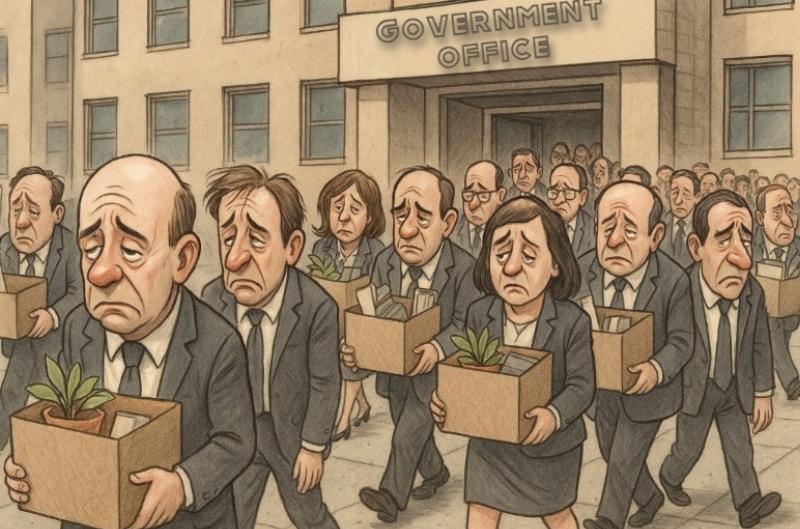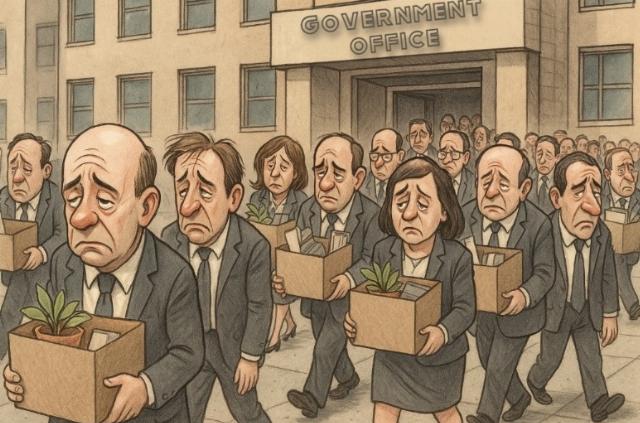


Even as Democrats seemed inexorably headed toward a government shutdown rather than accepting the Continuing Resolution, the big question was whether Trump would use a shutdown to shrink the federal government. That question continued as Democrats were obdurate in their refusal to negotiate any compromises on their plans for healthcare for illegal aliens and to provide services for transexuals at home and abroad.
While some federal programs must wait for funding until the shutdown ends, other programs can be canceled when the money runs out, or, at the very least, their employees can be permanently fired. Democrats assumed that Trump was bluffing when he said that’s what he would do during a shutdown. After all, he’s been known for getting out over his skis on certain policies and then walking back.

Image created using AI.
Well, to the delight of those who crave a smaller, less intrusive, less leftist federal government, Trump wasn’t bluffing. White House budget director Russ Vought, who has been champing at the bit to make the government smaller, leaner, and less leftist, finally got the go-ahead. Yesterday, the layoffs began—or at least, the process for making them happen began, which is an important point:
The Trump administration plans to lay off more than 4,100 federal workers from seven departments in response to the partial government shutdown, according to a court filing submitted Friday.
The administration filing, on behalf of the Office of Management and Budget, came in response to a court order stemming from a lawsuit filed Sept. 30 by the American Federation of Government Employees and other unions challenging the administration’s authority to conduct mass firings during a shutdown.
The document also made clear that additional layoffs, known as reductions-in-force or RIFs, are possible because some agencies have yet to decide whether to conduct layoffs or have made preliminary decisions that are not yet finalized.
[snip]
The decision to move ahead with layoffs marked an escalation in a White House pressure campaign against Senate Democrats, who have refused to back a House-passed continuing resolution to reopen the government.
As of now, the Trump administration is in a win-win position: Either the Democrats cave on the budget to stop the firings, which will make them look weak to their rabid base, or government workers get their walking papers.
Meanwhile, all of America will have been made aware of two very important things: First, the Democrats have locked themselves into such extreme and disfavored positions (illegal aliens and transgenderism) that they can’t find a way to get back to normal.
Second, Obamacare is now, as it always was, unaffordable. We conservatives have known that forever, but it took the budget fight for the left to admit it, as exemplified in a now well-known editorial from the Washington Post:
The real problem is that the Affordable Care Act was never actually affordable. President Barack Obama’s signature achievement allowed people to buy insurance on marketplaces with subsidies based on their income. The architects of the program assumed that risk pools would be bigger than they turned out to be. As a result, policies cost more than expected.
Every Democrat policy lives in unicorn-land, a place of fantasy, where good intentions make up for bad ideas that are then made worse because they’re poorly implemented. It’s time to put the free market back to work—and, with a smaller federal government, taxpayers should have more money to make smart choices that work for them, and not what some bureaucrat thinks they need, in the health insurance marketplace.
(By the way, I have sympathy for those workers who will lose their jobs, unless they are rabid leftists, in which case they can learn to code. As for the normal people who work in the government, my sympathy stops short of saying that they should keep jobs that are an unsustainable burden on the American taxpayer. I wish them luck in the private sector.)
